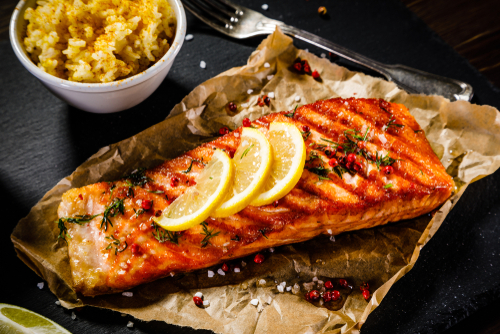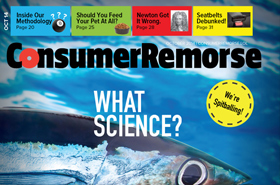Salmon Nutrition: Everything You Need to Know About Salmon
Known for its pink color, health benefits and versatility, salmon has been at the center of the seafood world for years. From commonly eaten species and salmon nutrition information to the farmed vs. wild debate, find everything you need to know about salmon here.
Types of Salmon
Salmon is primarily classified in one of two main categories: Pacific and Atlantic. The Atlantic salmon found in supermarkets and restaurants is farmed; its wild counterpart is protected under the Endangered Species Act, so commercial fishing of Atlantic salmon is prohibited in the United States. Meanwhile, species within the Pacific salmon category are by and large wild-caught from the west coast of the U.S., primarily from Alaska. Within the Pacific salmon category, the most commonly eaten species for salmon nutrition are Chinook, Pink, Chum, Coho and Sockeye.
- Atlantic: Atlantic salmon is farm-raised all over the world. Like wild-caught salmon, their flesh is reddish-orange or pink. Atlantic salmon have a high oil content and firm, fatty texture. Historically, Atlantic salmon are spawned and raised in on-land hatcheries until they are large enough for transfer to net-pens in coastal waters. More recently, however, companies have developed land-based farming operations from spawning through harvest.
- Chinook: Chinook salmon, commonly referred to as King salmon, is the largest of the species wild-caught in the Pacific, weighing twenty pounds on average. Chinook have a bold flavor, high fat content and a buttery, flaky texture. Their meat is red.
- Sockeye: Sockeye salmon is known for its rich flavor and has the reddest flesh of the wild salmon species. Almost all the sockeye salmon commercially harvested in the United States comes from Alaska fisheries. Sockeye is firm and fatty.
- Pink: Pink salmon is the smallest but most abundant species wild-caught in Alaska, and to a smaller extent Washington and Oregon. Pink salmon typically weighs between two and three pounds. It has a lower oil content, which makes it a leaner and mild-flavored fish with soft, pale pink meat.
- Chum: There are hundreds of stocks of Chum salmon in Alaska and several other Pacific stocks. Chum salmon, also called Keta, have a firm and meaty texture, making them ideal for smoking or grilling. Chum salmon has lower oil content, which gives it a mild flavor.
- Coho: Coho salmon is known for its orange flesh and is the second largest of the wild Alaska salmon species. Coho salmon has a high oil content and becomes firm and flaky when cooked.
Salmon Nutrition
Salmon is one of the most nutrient-packed foods you can eat. A three-ounce serving is rich in protein, vitamin B12, selenium and healthy omega-3 fatty acids. Omega-3s are essential to eye, brain, and heart health. Omega-3s, specifically eicosapentaenoic acid (EPA) and docosahexaenoic acid (DHA) found in salmon, are crucial for brain growth and development in infants and are very beneficial when eaten during pregnancy.
Omega-3s cannot be made by the body, so they must be consumed from food, like salmon. The American Heart Association recommends eating fish at least two times per week, specifically highlighting, “fatty fish like salmon.” On top of beneficial nutrients and protein, salmon is also low in saturated fat and sodium.
Eating seafood, like salmon, helps to reduce the risk of heart disease, optimizes brain health, and promotes a healthy weight. The U.S. government’s Dietary Guidelines for Americans recommends eating two to three servings of a variety of fish a week, including salmon.
Farmed Salmon vs. Wild Salmon
Farmed-raised and wild-caught seafood work together to provide a sustainable global seafood supply. Currently, 67% of salmon eaten in the United States is farmed and 33 percent is wild-caught. Both are excellent choices for a healthy, sustainable meal.
Modern-day aquaculture was revolutionized by a growing world population and demand for seafood coupled with the fact that wild fisheries are effectively and sustainably fished to their maximum sustainable yield. Pacific salmon caught in the U.S. is considered one of the best-managed fisheries in the world. Wild-caught salmon is iconic, delicious, healthy and sustainable. Farm-raised salmon is also regulated and monitored to ensure farming practices have a minimal impact on the environment and ecosystem. Farm-raised salmon is widely available, delicious, healthy and sustainable.
The U.S. government’s committee for the 2015-2020 Dietary Guidelines for Americans thoroughly explored the health and safety of both wild-caught and farm-raised fish. The committee, comprised of 14 credentialed doctors and registered dietitians, concluded that, “based on risk/benefit comparisons, either farmed or wild-caught seafood are appropriate choices to consume to meet current Dietary Guidelines for Americans for increased seafood consumption.”
When it comes to choosing wild-caught salmon or farm-raised salmon, it’s not an either, or scenario. Both types of salmon are a smart choice and the decision ultimately depends on an individual’s flavor preference, price, and availability.
Salmon Color and Farmed Salmon
Wild salmon’s diet consists of shrimp and other sea creatures that contain carotenoids which give the fish its signature color. Farmed salmon gets its color the same way that wild-caught salmon does: from food.
CNN’s Chief Medical Correspondent, Dr. Sanjay Gupta, devoted an extraordinary amount of time and research into an expose for 60 Minutes about farmed salmon where he explained that the “dyed” salmon narrative was simply a myth that needed rebutting: “It’s not accurate to call these artificial dyes. I think people conjure up this image of the farm salmon being injected with something that causes it to turn that pink color. That’s not what’s happening here. It’s a much more natural occurring process where the farmed salmon eat a type of food that causes a reaction in the body, just like the wild salmon does, and that causes that more pinkish color.”
The Skinny on Salmon
Salmon is widely considered a “superfood” and is a smart choice whether salmon is farmed or wild-caught, it’s a simple choice, an easy and delicious way to get valuable nutrients. With the help of sustainable fishing practices and aquaculture, this versatile species can continue to flourish and arrive on tables and in markets all around the world so that all can benefit from salmon nutrition. For salmon recipes, visit Dish on Fish.
TIME magazine continues to fail its readers
After our initial letter to TIME magazine, they were unwilling to make any changes, but suggested we send something forinclusionin an update to the piece. We have little faith they will use any significant portion of the letter, so we’re making it available here.
March 31, 2015
Siobhan O’Connor
Health Director
TIME Magazine / TIME.com
Dear Editor:
The deeply misleading article by reporter Mandy Oaklander [Should I Eat Canned Tuna; 3/26] peddles some of the most wrongheaded advice about tuna right at a time when the FDA is warning that Americans need much more seafood in their diet. TIME falsely implies that tuna is somehow contaminated when in reality the newest research from U.S. food safety regulators is that even the most sensitive subpopulations, children and pregnant women, can healthily eat up to 56 ounces (3.5 lbs) of albacore tuna per week (which equates to 3-4 albacore tuna sandwiches/day). This is new, independent, published, peer-reviewed science, not conjecturer.
Nutrition reporting about the health benefits of seafoods like tuna should carry the highest level of journalistic accuracy and objectivity. If you stop drinking soda or eating french fries for example, as Ms. Oaklander has previously reported on, nothing bad will happen. But if you curtail or refrain from eating seafood (and tuna is the most widely available and affordable) the American Medical Association (AMA) warns there is a greater risk of heart attacks and strokes in adults and that infants and children suffer lowered IQ outcomes.
But the FDA and AMA each know that irresponsible, shoddy reporting like TIMEs is one of the factors causing Americans to eat less seafood each year which is precisely why promoting the new guidance to eat more seafood is the focus of national health authorities.
Ms. Oaklander ignored our questions and TIME Magazine disregarded them too. We asked why Ms. Oaklander withheld the fact that theres never been a case of mercury toxicity from the normal consumption of commercial seafood in any American medical journal? And why she cherry-picked a mere five medical sources and presented that as a representative sample? When, in fact, 120 peer-reviewed studies from 1972-2013 were conducted on this topic by researchers in Poland, New Zealand, Japan, Canada, Denmark, Britain, and the United States nearly every single major study on the subject conducted over four decades confirms that the value of seafood consumption for women and their developing babies far outweighs the risk.
Incredibly, TIME Magazine even disagrees with itself on this subject when it published a separate story less than two months ago that named tuna one of the 50 healthiest foods in the world. The self-contradiction alone tells readers all they need to know about TIMES unreliability on nutrition advice. Isnt it TIME for more careful, accurate reporting? And what about accountability when the distortions are called out? TIME seems to think they can ignore the shortcomings in its reporting and that readers wont care.
Sincerely,
Brandon Phillips, NFI
Sr. Director of Communications
National Fisheries Institute
NBC News makes healthy eating during pregnancy a lot harder
Stacey Naggiar,
Associate Producer, Health
Health & Medicine
VIA EMAIL
Dear Ms. Naggiar,
I am writing to address fundamental editorial problems with your online article, Pregnant and Poor? Eating Healthy Just Got Harder” and associated segments embedded in the article.
The reason eating seafood during pregnancy just got harder is because Consumers Reports, a consumer electronics magazine, is propagating flawed and reckless nutrition recommendations that fly in the face of more than a decade of seafood science. In fact, the Food and Drug Administration (FDA) has blasted Consumer Reports for its flawed methodology and its limited analysis that focuses exclusively on the mercury levels in fish without considering the known positive nutritional benefits attributed to fish.
Its concerning that a venerable outlet like NBC News gives equal editorial weight to an organization whose core competency lies in testing toasters and refrigerators as it does to the FDA, the federal authority on food safety and nutrition.
Both the segment and written article fail to give space to FDAs acting chief scientist Stephen Ostroff, M.D. who, talking about the June 2014 updated seafood advice to pregnant women said, A large percentage of women are simply not eating enough fish, and as a result they are not getting the developmental and health benefits that fish can provide. Studies very consistently demonstrate that among women who consumed more fish during pregnancy or at least the amounts were currently recommending that there were improvements in children.
Yet, the segment and article do feature Urvashi Rangan, director of consumer safety and sustainability at Consumer Reports a title that does not suggest expertise in either nutrition or obstetrics.
The new FDA/EPA advice to pregnant women is based on a 10 year review of 110 independent, published, peer-reviewed studies. The volume of time, attention and resources given to the FDA/EPA study absolutely dwarfs any review a consumer electronics magazine could accomplish, yet both are given equal editorial weight; in fact Consumer Reports is given more editorial weight than the decade long peer-reviewed investigation by the worlds preeminent food and environmental safety regulators. Such misrepresentation does a huge disservice to your readers.
Accurate scientific context is missing throughout the piece. For example, Consumer Reports Rangan is quite concerned while claiming certain FDA data on light canned tuna found levels of mercury that were twice what the average is. She forgets to add that the FDA limit for mercury in fish is 1.0 ppm (with a 10-fold safety factor built in, making the level of concern 10.0 ppm.) The average mercurylevelfor canned light tuna is 0.1 ppm. The simple math shows Consumer Reports expressing public alarm about mercury levels at 0.2 ppm. Keep in mind, this is despite the demonstrable fact that the FDAs action level of 1.0ppm was established to limit consumers methyl mercury exposure to levels 10 times lower than the lowest levels associated with adverse effects.
Suggesting low-income pregnant women avoid canned tuna is wildly irresponsible. The FDAs own calculations (page 113) find pregnant women can eat up to 56 ounces per week of albacore tuna, and 164 ounces per week of light canned tuna. Canned tuna is an affordable and accessible way for women to eat seafood during pregnancy.
I look forward to your review of and comment on our concerns.
Lynsee Fowler
Communications Manager
National Fisheries Institute
cc Lisa Tolin
Senior Health Editor
The EWG Mercury Conspiracy Lives On
The professional fearmonger, anti-vaccination-conspiracy-theory-pusher, and all-around activist shop that is the Environmental Working Group (EWG) is out today with another addition to their collection of flawed reports on mercury and seafood. This new EWG’s Consumer Guide to Seafood is a rehash of the same debunked and tired tropes EWG has been trying to push on the public for years.
Like any tried-and-true conspiracy theorist, EWG continues to argue despite the growing reams of evidence on the topic as well as recommendations from the World Health Organization, the United States Department of Agriculture, the Institute of Medicine, the Food and Agriculture Organization, and recent joint draft advice from the Environmental Protection Agency and Food and Drug Administration (which itself relied on hundreds of independent, published, peer-reviewed studies) that they, and only they, are in a position to tell the truth about mercury in fish.
Take for instance EWG’s claims that the current safe dose level established by the EPA in 2001 [is] now considered outdated and too high by many scientists. EWG doesn’t attempt to answer which scientists, or how many scientists, or what their qualifications are, or offer any guess as to why this purported group has a different take on this issue. Instead, they ask readers to take it as a matter of faith that their pronouncements on mercury trump the scientific consensus reached through hundreds of rigorous, peer-reviewed studies.
EWG also fails to note that the safe dose levels established by the FDA itself includes a 10-fold safety factor, meaning that a fish would have to exceed the current level by a factor of ten to reach dose levels actually associated with adverse effects.
EWG warns that pregnant women and children should limit or avoid canned tuna. Of course this flies in the face of the FDA’s new draft advice, which confirms not only that canned tuna is a healthy choice for pregnant woman and children, but that women should eat at least 8 ounces of a variety of seafood to enjoy health benefits and avoid risks to themselves and their children.
To take agenda-driven activists like EWG seriously would itself be a serious mistake. When it comes to health and nutrition, let’s stick with the experts.
A Few Retorts for Consumer Reports
A recent Consumer Reports article on tuna goes against the vast and continuously growing body of peer-reviewed research on the positive effects of seafood consumption on health. Despite our repeated warnings about their reckless behavior, they continue to mislead their readers with their fear mongering.
So we decided that if Consumer Reports couldn’t get the facts right, we’d do it for them. So here’s a first look at volume 1, issue 1 of Consumer Remorse.
Rodale News editors expected to live to 120 and be capable of human flight?
Emily Main and Leah Zerbe have done it again. You know them, the activists writing for Rodale News who have a long history of botching facts, skewing reports, and throwing the rules of journalism out the window the second they start writing about seafood. Balance, research, expertsblaaaaa, who needs it?
Just when we thought they couldnt distance themselves any further from the mainstream, science-based community they come out with, 14 Foods You Should Never Eat. Its an article that illustrates what weve been saying all along: Rodale has no perspective on real world nutrition or food consumption whatsoever.
After first suggesting readers take notes, so you, too, can avoid the worst of what grocery stores have to offer, they tell readers to avoid swordfish, followed by alarming recommendations to avoid nonorganic strawberries, diet soda, anything from McDonalds, canned tomatoes, white chocolate, and popcorn. Oh, and then theres the moment they follow their avoid popcorn slide, with a slide saying to actually avoid any corn at all. Realistic, if nothing else.
But, as expected the Rodale Dream Team finds a way to further marginalize their reporting when they suggest readers avoid bread. Thats right, bread. While the United States 2010 Dietary Guidelines for Americans (DGAs) suggests a focus on nutrient-dense foods like whole grains, where they specifically give the example of whole wheat bread, Emily and Leah tell readers otherwise. And it’s not left open to interpretation, either: “And I don’t mean white bread; I mean all bread: white, whole wheat, whole grain, sprouted, organic, French, Italian, fresh, day-oldall of it.”
I dont know about you, but I prefer to take nutrition notes when Im hearing from the PhDs, MDs, and RDs that were appointed to the federal Dietary Guidelines Advisory Committee, not from the Rodale news team with no nutrition expertise and a whole lot of agenda-driven rhetoric.
The DGAs also recommend that Americans increase the amount and variety of seafood consumed by choosing seafood in place of some meat and poultry.
Real seafood reports, like this one seen in The Atlantic this week, rely on sources like Dr. Cyrus Raji from UCLA, Drs. Deborah Barnes and Kristine Yaffe of UCSF and references to peer-reviewed journals like Neurology and Lancet Neurology. Meanwhile, Rodale continues to rely on the likes of the Center for Science in the Public Interest, Womens Voices for the Earth, and its own CEO.
Its great that Emily Main and Leah Zerbe are the only ones with a perfectly balanced, nutrient-rich diet, should we expect both to live to 120 and be capable of human flight? Or should we expect at sometime theyll stop publishing holier-than-thou drivel that flies in the face of actual nutrition recommendations? Probably neither. I guess well just expect more of the same.
Senator McCaskill to Dr. Oz: The scientific community is almost monolithically against you
Yesterday Dr. Mehmet Oz testified before a Senate committee about the accuracy of the medical advice he gives on his show. Readers of this blog would be shocked, SHOCKED to find that by his own admission he has issued advice that would not pass scientific muster.
As part of her questioning Senator Claire McCaskill ripped into Oz, asking why he need[ed] to say this stuff because you know its not true.
In reply, Oz said that he personally believe[s] in the items I talk about on the show though he admitted that they would not pass FDA muster.
McCaskill dismissed his personal beliefs stating, the scientific community is almost monolithically against you.
Its not surprising that McCaskill and the scientific community have lined up against Oz and his personal beliefs. As we have documented many, many, many, times Oz has a penchant for playing fast and loose with the facts while ignoring key scientific literature.
Each time Oz advances his unfounded theories he risks promoting unhealthy behavior in his audience and their loved ones. And as we have noted, this can have very real effects in the health and wellbeing of people. For example, when Oz told his viewers that mercury in fish was a concern for the general population, or when Oz interviewed activist Dr. Jane Hightower about her mercury-focused practice and her pet diagnosis of fish fog, he helped encourage people to consume less fish. Meanwhile a Harvard study shows eating less fish costs up to 84,000 lives per year.
Its encouraging to see people calling Dr. Oz out for his improper advice and demanding accountability. We hope as questions continue to mount towards Oz and others like him the public will learn to place their trust in science, not personalities and their strange beliefs.
Evidence Continues To Grow On Benefits of Seafood Consumption
The evidence for the health benefits of eating seafood has been steadily growing over the years. Studies have shown that higher seafood consumption improves cardiac health, boosts fetal and infant cognitive development, and is associated with higher intelligence at age 17. Yet activists continue to scaremonger over seafood consumption, insisting that trace levels of mercury found in fish pose a risk to humans.
These health concerns have largely been been dismissed by the scientific community, and the government, in part because the mercury levels cited in alarmist cases are below the threshold set by the Food and Drug Administration, which itself has a 1,000% safety factor. And new evidence continues to pour in confirming that mercury associated with normal seafood consumption is a non-issue. Earlier this month Dr. Nicholas Ralston from the University of North Dakota presented evidence that selenium rates in tuna far outweighed their mercury rates. Why is this important? Because selenium binds to mercury, neutralizing its effects.
Of course, this evidence probably wont matter to the activists who continue to fearmonger despite the mountains of evidence against them. But for the public, who are more concerned about real nutrition and scienceand not the extremists agendaRalstons research provides another reason why eating seafood like tuna can help you lead a long and healthy life.
Real Simple Makes It Real Complicated When It Comes to Eating Seafood
January 10, 2014
Dear Ms. Harris,
I was surprised and disappointed by the section regarding fish in your article How Much Is Too Much in the January, 2014 issue ofReal Simple. While author Sarah Copeland sets out to provide health benefits for your readers, her piece on fish creates more myths than it resolves misleading your readers in several ways.
Copeland writes that all fish are at risk of being tainted with mercury, citing an anonymous group of environmentalists for the assertion.In fact, the Food and Drug Administration hasstated thatfor most people, the risk from mercury by eating fish and shellfish is not a health concern and no peer-reviewed medical journal has ever published evidence of a case of mercury poisoning caused by the normal consumption of commercial seafood in the U.S. The USDAs Dietary Guidelines for Americans urges Americans to eat at least two fish meals a week.
Copeland also states that mercury exposure is linked with neurological and reproductive health problems. What Copeland does not tell her the readers is that these problems were the result of environmental disasters more than 50 years ago that neither resemble nor are applicable to how average American families eat seafood.
Copeland also incorrectly asserts that cold-water fish are safer sources that minimize toxins, and provides no evidence to back up her assertions. The fact is that all fish are subject to the same health and safety requirements.
Finally, Copeland inaccurately states that Albacore tuna should be avoided by pregnant or breast-feeding women. In fact, the USDAs Dietary Guidelines for Americans encourages pregnant and breastfeeding women toincreasethe amount of fish they are currently eating to at least two meals per week, to support healthy brain, eye, and spinal cord development for their children.False statementslike Copelands abovereinforce the serious seafood deficiency among pregnant women who eat less than half a serving (or 2 ounces) each week. Ultimately, it is their babies brain health that is suffering.
Only four, rarely eaten fish are suggested to avoid during pregnancy, and tuna is not one of them.Mercury in ocean fish is naturally-occurring in trace amounts and is the product of underwater volcanic activity. These miniscule amounts are simply not a concern for pregnant and breastfeeding women. For pregnant women eating fish from a local stream or pond, each state has local water advisories they can check. However, most American women eat fish purchased from their grocer.
As Copeland herself points out, fish are an important part of a healthy diet and health organizations, including the American Heart Association, concur. Real Simplequite simply got the story on fish wrong, unnecessarily turning seafood choices into a mine field and adding to the confusion of women who are, according to all the data, already seafood deficient thanks in large part to stories like this. Considering the material harm this could cause your readers, I would like to request an itemized list of corrections in next months magazine, and as a service to your readers, an online story affirming that fish is a primary source of omega-3s that experts agree Americans need to eat more of, especially during pregnancy. Please let me know what resources you need to get this corrected and please reach out to us when doing seafood related stories in the future.
Sincerely,
Mary Anne Hansan
Vice President, National Fisheries Institute











